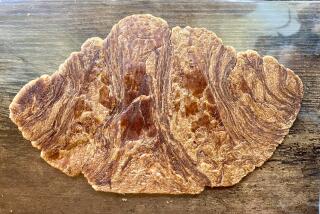A Few Trifles on Rice Pudding
- Share via
Most people like it with a lot of raisins in it, if they can face it to begin with. It is perhaps meant for the nursery . . . but that is where we should all return now and then, to simplify ourselves.
--M.F.K. Fisher on rice pudding
It’s hard to believe our lives would be simpler if we only ate more rice pudding, but if it tastes good, what’s the harm? Rice pudding may not be man’s greatest gastronomic accomplishment, but it is the ultimate comfort food. (You’ve heard of blendo architecture; rice pudding is blando food.)
And for a dish that’s been around for centuries, rice pudding has become pretty darn hip. It outsells apple pie by nearly 40% at The Grill in Beverly Hills and seems to be just as popular at the 2-month-old Daily Grill in Brentwood.
What’s more, nearly every world culture seems to have a version of the stuff. In India, it’s kheer, made with pistachio nuts, cardamom and sometimes rosewater. In Indonesia, it’s bubor ketan hitam, made with black glutinous rice, palm sugar and coconut milk. In bibingkang malagkit from the Philippines, the glutinous rice is white and the pistachios are replaced with peanuts or pili nuts.
“Eight-Treasure Rice Pudding” is how you’ll see China’s version translated. And then there’s the rice pudding from Korea, Afghanistan, Colombia, Greece, Denmark . . . the list is long.
In America, of course, we dust it with either nutmeg or cinnamon, and spike it with plenty of raisins. We probably picked up the habit from the British, who have eaten several odd dishes resembling rice pudding--pottages (a.k.a. gruel) and puddings that resemble sausages--throughout their history.
But no one country can claim credit for inventing rice pudding--and few want to. After all, it’s not exactly a difficult dish to make; anywhere there is rice and milk and some sort of seasoning, there is rice pudding. But north Thailand is where historians have decided that rice made its first appearance, back in 3500 BC. And because India is known for both its rice and its many ways with milk, it’s not unreasonable to guess that milk and rice first met there.
What is harder to figure is when rice pudding and writers hungry for metaphors met. Mark Twain made pudd’nhead a popular insult, but somewhere along the way, rice pudding became a trendy put-down. It’s even spread to the pages of the Los Angeles Times:
“What bugs me? . . . Desperate, short-term executives on NBA teams sell out the team’s future . . . and owners with rice pudding for brains give their stamps of approval.” That’s from a Scott Ostler column in June of 1986.
Other rice pudding phrases:
” . . . Gets his nose turned into rice pudding,” Mike Downey (May, 1986), and “Lively ball? These guys could hit rice pudding 400 feet,” George Will (July, 1987).
Ellen Goodman (August, 1986) made use of the pudding-as-parable technique: “I know that if you keep it too long, revenge, like (a) favorite rice pudding, turns rancid.”
Art Buchwald (December, 1986) feigned pudding exasperation: “Why should the White House give you their satellite photos to permit Baghdad to make rice pudding of all my hardware?”
But it was Joan Rivers, in a 1987 story by Nikki Finke, who showed that rice pudding is the perfect detail for the first line of a bad novel. Describing her late husband, Edgar, she said, “He loved Faberge eggs all covered with diamonds but also loved perfectly cooked rice pudding. That was the dichotomy of his character.”
More to Read
Eat your way across L.A.
Get our weekly Tasting Notes newsletter for reviews, news and more.
You may occasionally receive promotional content from the Los Angeles Times.







